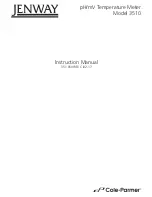
Remote programming
100 000 cts digital multimeter
3
Command syntax
Common
commands
Specific
commands
Keywords
#
The brackets ([ ]) are used to frame a keyword which is optional during
programming; i.e. the instrument will execute the command whether the
keyword is optional or not. Uppercase and lowercase are used to
differentiate the short form of the keyword (uppercase letters) and the long
form (whole word).
The instrument accepts the uppercase or lowercase letters without
distinction.
FUNC:SIN is equivalent to
SOURCE:FUNCTION:SHAPE SINUSOID
Parameters
The parameters, if any, are separated from the keyword by a space (' '). A
command can accept parameters of a defined type, a literal expression or a
combination of both.
The defined-type parameters are marked by the characters < >.
The brackets ([ ]) mean that the parameters are optional.
The vertical bar ( | ) may be read as an "or", it is used to separate the
various possible parameters.
Separators
The separator ' : ' descends in the next directory or returns under the root, if
preceded by a ' ; '.
The separator ' ; ' separates two commands in the same directory or marks
the end of a directory command, enabling a return to the root level by
adding the separator ' ; '.
The separator ' ' (space) separates the keyword from the following
parameter.
Terminators
<T> used as a general term designating a terminator.
T is the character CR (ASCII code 13 or 0x0D) or the CR character followed
by the LF character (ASCII code 10 or 0x0D)
A command line must not exceed 80 characters; it is ended by a terminator.
*
Mnemonic code
Terminator
Short keyword
Digital
suffix
Parameter
Long keyword
;
:
:
' '
?
;
Terminator
?




































